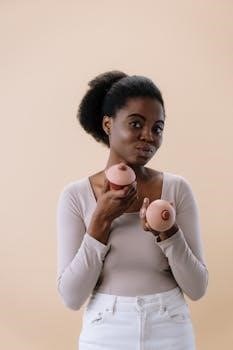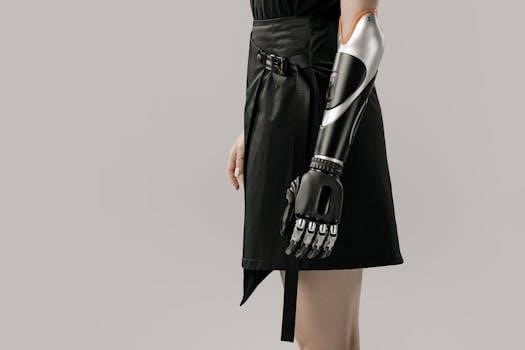Understanding the diversity of female body shapes is crucial for promoting body positivity. Many sources suggest over nine types, broadly falling under five categories. These variations are key to individual style and self-acceptance.
Understanding Body Shape Diversity
The concept of diverse female body shapes moves beyond a singular ideal, acknowledging that bodies vary significantly in proportions and structure. While some classifications use nine categories, these often condense into five core types. This diversity arises from genetic factors, bone structure, and fat distribution, resulting in a wide range of beautiful forms. Embracing this variety is essential for fostering a positive body image. It is important to recognize that each body shape is unique and deserves to be celebrated for its distinct characteristics. Understanding these differences encourages self-acceptance and helps in making informed decisions about fashion and health.

Common Female Body Shapes
Female bodies are often categorized into shapes like rectangle, hourglass, pear, and apple. These categories help understand variations in bust, waist, and hip measurements, aiding in style choices.
Rectangle Body Shape Characteristics
The rectangle body shape, also sometimes referred to as a straight or athletic shape, is characterized by a relatively uniform measurement across the bust, waist, and hips. Individuals with this shape typically have minimal waist definition, meaning there isn’t a significant difference between their bust, waist, and hip circumferences. The shoulders and hips are often roughly the same width, creating a straight silhouette. This body type is often described as having a balanced figure with a more linear appearance. Many find that their weight is distributed evenly throughout their body. This shape is also associated with a lack of curves, though this is not always the case.
Hourglass Body Shape Characteristics
The hourglass figure is distinguished by a balanced proportion between the bust and hips, with a noticeably narrower waist. This classic shape is often considered to be the most symmetrical, with the bust and hip measurements being roughly equal. The waist is significantly smaller, creating a defined curve between the upper and lower body. Shoulders are typically rounded and proportionate to the hips. Those with an hourglass figure often find that their weight is distributed evenly throughout their body, though it may vary. Legs are usually in proportion with the upper body. This shape is often celebrated for its balanced and curvy appearance.
Pear (Triangle) Body Shape Characteristics
The pear, or triangle, body shape is characterized by having hips that are wider than the shoulders and bust. This body type often features a defined waist, which accentuates the difference in size between the upper and lower body. Individuals with a pear shape tend to carry more weight in their lower body, specifically around the hips, thighs, and buttocks. The upper body, including shoulders and bust, typically appears smaller in comparison. This shape is very common, with many women falling into this category. The focus in styling is often on balancing the proportions by drawing attention to the upper body.
Apple (Inverted Triangle) Body Shape Characteristics
The apple, or inverted triangle, body shape is defined by having broader shoulders and a larger bust compared to the hips. Individuals with this shape often have a less defined waist, and their weight tends to accumulate more around the upper body and midsection. The legs are typically slimmer in proportion to the upper body. This body type can sometimes be described as having a “top-heavy” appearance. The focus in dressing the apple shape is often on creating balance by adding volume to the lower body and defining the waistline to create an hourglass effect. It’s a common shape with its own unique characteristics.
Body Measurements and Identification
Accurate body measurements are essential for identifying body shapes. Bust, waist, and hip measurements are key. These measurements help in understanding proportions and selecting suitable styles.
Accurate Measurement Techniques
To accurately measure your bust, wrap the tape fully around the fullest part, keeping it parallel to the floor. For the waist, measure the smallest part of your torso. The tape should be snug but not too tight. Measure hips at the widest point, again ensuring the tape is level. These measurements should be taken without constricting clothing. It’s important to pull the tape tight enough to get a precise measurement, but not so tight as to squish your body. Taking accurate measurements is the first step to understanding your body shape and selecting clothing that complements your figure. This allows you to feel confident and comfortable with your wardrobe.
Using Body Measurements for Shape Identification
Once you have accurately measured your bust, waist, and hips, you can begin to identify your body shape. If your bust and hips are roughly the same size and your waist is less defined, you may have a rectangle shape. An hourglass figure is characterized by similar bust and hip measurements with a significantly smaller waist. A pear shape has wider hips than bust. An apple shape features more volume around the bust and waist than the hips. By comparing these measurements, you can determine which category best fits you. These measurements are a practical tool for informed style choices.

Body Image and Self-Acceptance
Embracing the diversity of female bodies is essential for self-acceptance. Understanding your unique shape promotes confidence and positive body image, moving beyond societal norms and expectations.
Promoting Body Positivity
Promoting body positivity involves recognizing and celebrating the diverse range of female body shapes and sizes. It encourages a shift away from unrealistic beauty standards often portrayed in media. This includes fostering self-love and acceptance, regardless of body type. It is about understanding that beauty comes in many forms and that each body is unique and valuable. Education on different body types helps women to identify and appreciate their own natural shape. This knowledge empowers them to make informed choices about fashion and fitness that complement their bodies, not conform to external ideals. Ultimately, body positivity is about fostering a culture of self-respect and admiration for the diversity of the female form.
Impact of Social Media on Body Image
Social media significantly impacts body image by often presenting a curated and often unrealistic portrayal of female bodies. This can lead to negative self-perception and body dissatisfaction. The constant exposure to idealized images can make individuals compare themselves unfavorably, contributing to feelings of inadequacy. Filters and editing tools further distort reality, setting unattainable standards. It’s crucial to recognize that social media often presents a narrow view of beauty, neglecting the diversity of body shapes and sizes. This can promote harmful ideas about what a healthy or desirable body should look like, and reinforce the idea that only certain body types are acceptable. Being mindful of the content consumed online is vital for fostering a healthy body image and self-esteem.
Styling for Different Body Types
Understanding your body shape is key to choosing styles that enhance your natural figure. There are specific fashion tips for each body type that can boost confidence and flatter your unique form.
Fashion Tips for Each Body Shape
For rectangle shapes, creating curves with ruffles and defined waists works well, while hourglass figures benefit from fitted clothing that accentuates their balanced proportions. Pear shapes can balance their lower body with A-line skirts and wider necklines. Apple shapes can create a more streamlined look with empire waists and flowy tops. Inverted triangles should opt for styles that add volume to the lower body like flared pants. Knowing these tips helps you choose outfits that flatter your unique shape, boosting confidence and enhancing your personal style, ultimately embracing your body’s natural beauty and proportions. Each shape benefits from specific strategies.

Additional Body Type Information
Beyond basic shapes, consider ectomorph, mesomorph, and endomorph categories. There are also variations and combinations of the primary body types, making each individual unique in their bodily structure and form.
Ectomorph, Mesomorph, Endomorph
These terms describe body composition and metabolic tendencies, not just shape. Ectomorphs often have a lean build, with less muscle and fat. Mesomorphs tend to have a more muscular physique and can gain or lose weight relatively easily. Endomorphs, on the other hand, typically have a higher body fat percentage and might find it more challenging to lose weight. These categories provide insight into how individuals might respond to different fitness and nutrition approaches, complementing the understanding of body shapes. These are not strictly ‘shapes’ but rather tendencies that coexist with the commonly discussed body shapes.
Body Shapes Beyond the Basic Types
While common categories like rectangle, hourglass, pear, and apple are useful, body shapes exist on a spectrum. Variations occur due to differences in bone structure, muscle mass distribution, and fat storage. Some may find their shape is a combination of two types, or a slightly modified version of a standard shape. Terms like ‘inverted triangle’ and ’round’ are often used to further define these variations. Exploring these subtleties allows for more personalized style advice and a deeper understanding of individual body diversity. It is important to remember that these are guides and not fixed labels.

Conclusion
Embracing individual body shapes is essential for self-acceptance and confidence; Understanding your unique form allows for informed styling choices and promotes a positive body image, celebrating all variations.
Embracing Individual Body Shapes
Celebrating the uniqueness of each female form is paramount, moving beyond societal pressures to conform to a single ideal. Acknowledging that bodies come in diverse shapes and sizes fosters self-acceptance and confidence. Understanding your body type empowers you to make informed style choices that flatter your natural figure and enhance your overall well-being. The beauty of the human form lies in its variability, and embracing this diversity allows each woman to appreciate her own unique physical attributes. This shift in perspective encourages a more inclusive and body-positive approach to fashion and self-perception, promoting a culture of self-love and appreciation for all body types.
